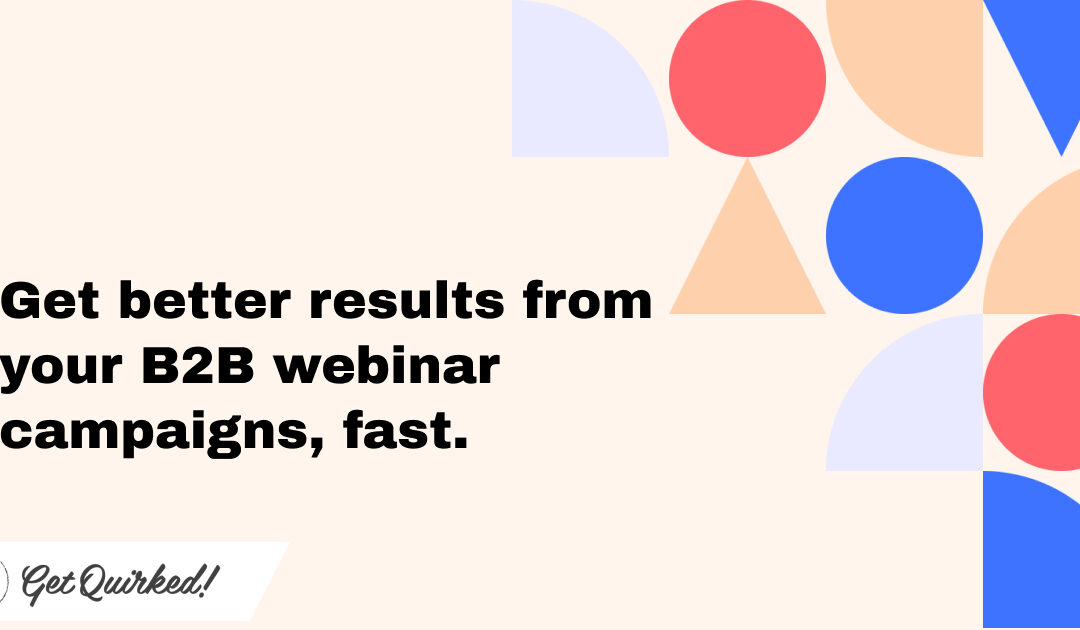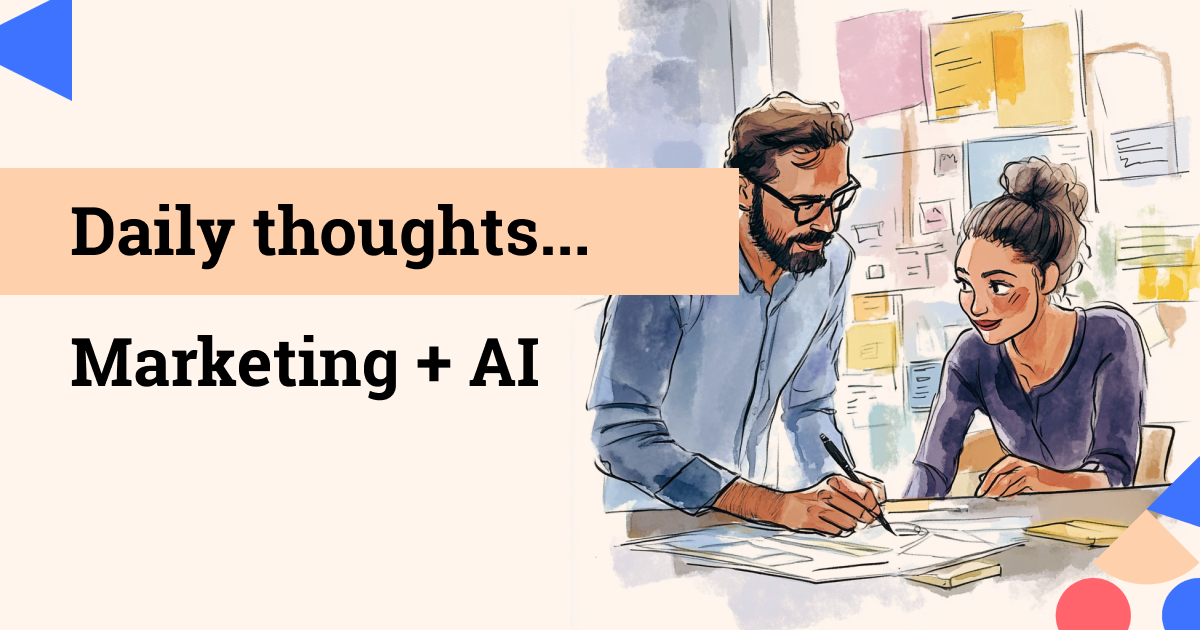Connecting with any audience in B2B marketing is tough these days. We have the most opportunities to connect than we’ve ever had before, which is both a blessing and a curse. However, there are a few tried and true tactics left to us that still build trust like nobody’s business with every B2B audience. Webinars being one of them. But it seems that no one has ever shared with B2B marketers that there is a formula that has been proven to work with small, medium, and large audiences. This article provides the mindset shift you’ll need, the process to follow and how to use your recorded webinars to have long-lasting promotional content that you can use to keep getting value out of each webinar far past it’s live publishing.
The Current Landscape of B2B Marketing in 2024
There are so freakin’ many tactics and options out there today. It’s overwhelming. So, what do we tend to do? What worked before. Which is my number 1 strategy, always, but as a starting point. Then we have to ask ourselves, is the situation similar enough to what worked in the past? If so, keep going. If not, it’s time to look at how you might modify your “blueprint”.
The popular digital channels I’ve seen utilized most often in B2B marketing are email, webinars, various digital advertising channels, content syndication, and several organic channels like social media and video media platforms like YouTube.
Channels are rarely the problem. Most often, success or failure is in how those channels are leveraged.
With that in mind, let’s dive into the channel, or more aptly medium, of webinars.
The Benefits of Using Webinars in B2B Marketing
What are the benefits of using webinars in B2B marketing? I thought I’d ask my generative AI tool, Notion, that question to see what the internet thinks. You know, for fun. Here are the top 3 benefits to using webinars in B2B marketing according to Notion AI:
- Webinars allow for direct engagement with your target audience, providing an opportunity for open dialogue and real-time feedback.
- Webinars can position your company as a thought leader in your industry by offering valuable and unique content.
- Recorded webinars offer long-term value as they can be repurposed into other content formats, such as blog posts, social media snippets, and email campaigns.
Now let’s evaluate these.
First, we’ll start with, “B2B Webinars allow for direct engagement with your target audience, providing an opportunity for open dialogue and real-time feedback.”.
- Starting with the idea of direct engagement, yes. This is true and a good thing to consider as you build your presentation plan later.
- Now, opportunity for open dialogue and real-time feedback… sometimes, but not inherent in all webinars. This is something you have to plan for and be able to support well for your audience members.
Second, “B2B Webinars can position your company as a thought leader in your industry by offering valuable and unique content.”
- Yes, all true. They “can” position your company as a thought leader… IF they offer value.
- True value to the audience member. Value that is actionable. That actually helps them. Keep this in mind, always. Your content is first and most importantly built to serve your customers (existing and/or prospective).
Finally, “Recorded B2B webinars offer long-term value as they can be repurposed into other content formats, such as blog posts, social media snippets, and email campaigns.”
- Love this one. I would also go further than content formats and suggest you should also repurpose into sales collateral.
- Add the main takeaways from your webinar content to your solution briefs, to your email signatures of sellers and business development teammates and customer service reps/managers. This creates a unity that, over time, will benefit both your marketing and sales efforts.
- This technique can also be leveraged to continue developing your customers into your absolute best customers.
I could add loads to this, but lets focus on one of the absolute most important benefits of using webinars.
Setting the buying criteria for your audience to improve conversion performance.
Playing off the Notion AI generated results, your B2B webinars are best utilized for direct engagement with your target audience to provide actionable educational value that drives to a next best action for the attendee. I try to focus on providing 2 options for every webinar attendee because I want to utilize this captured attention to segment my audience into those that are ready to learn and those that are ready to step forward on their journey faster.
Put simply, I want to segment into audience members and buyers. There is nuance in both, so stick with me.
Audience members I want to prime for continued engagement with content that educates them and gets them to take actions. These actions will, if done well, slowly build people into my best buyers.
Best buyers are the customers that tick all the right boxes for your organization. Those you have learned over time to be your best long-term clients, related to the notion of lifetime value (LTV). These customers are at the exact point in their journey of solving the problem you best solve that you need them to be so you can provide maximum value to them.
I call this “setting the buying criteria”, learned and slightly modified from the teachings of business and marketing leaders Jay Abraham, Dan Kennedy, and Frank Kern.
Here’s an example for those that are my own best buyers for B2B marketing strategy consulting:
- B2B marketing leaders with $20,000+ annual budget set aside for experimentation, looking to get even more from their playbooks and campaigns, and a team of people or agency partners to help quickly implement and test strategic modifications to their existing campaigns in the next 3 months.
This is highly explicit, as I don’t want to spend the time getting people to a solid base. That’s not where I can thrive and be extremely valuable to my clients.
So, I build webinars (& other content) that can help get them there, that guides them to their next best steps along the journey, wherever that may be.
For most, the best next step is to learn more about where to find the best opportunities. For a very small few, their best next step is to book a call with me.
And of those that book a call, even fewer are actually where they need to be to work with me, so I provide them their roadmap and keep up with them on their journey. I nurture them with content a bit more specific to their journey.
How to Create, Promote, and Present Successful B2B Webinars
Planning Your B2B Webinars
When you plan a webinar, a lot of times you’re starting from scratch. That’s crazy to me. Always start with a framework. There are several to choose from, but I like to start with the following:
- Topic & problem statement, tease solution or outcome they desire (the promise you are making to your audience)
- Journey, the audiences and yours to finding/implementing this solution
- Next best step – call to action
These 3 core elements should, in my opinion, be first always.
The reason for this is simple, you want to plot your story path around these 3 critical points.
Promoting Your B2B Webinars
If you are presenting a live webinar, you may want to create additional video content with your SMEs (subject matter experts). This content should tease the upcoming event and give a few of the takeaways in them to use as hooks to pull people into wanting to watch it.
This helps showcase the value that you’ll be bringing and primes the audience with exactly what they can expect to be, do, and or have by the end of the webinar.
Begin promotion at least 4 weeks out.
I suggest this so you have runway to gauge if your tactics are working. Some testing I’ve been a part of has shown that beginning promotion only 2 weeks before a live webinar is most likely too close to the event.
So please give yourself the time to execute properly and not stress.
Promoting a recorded, on-demand, or simulated-live webinar is a bit different than promoting a live event. All the same “selling” of value must occur, but you are not blessed or cursed by a deadline.
This also means that you can promote this webinar with video snippets from the webinar, create quote graphics to use on social, can be included in monthly newsletters, and more.
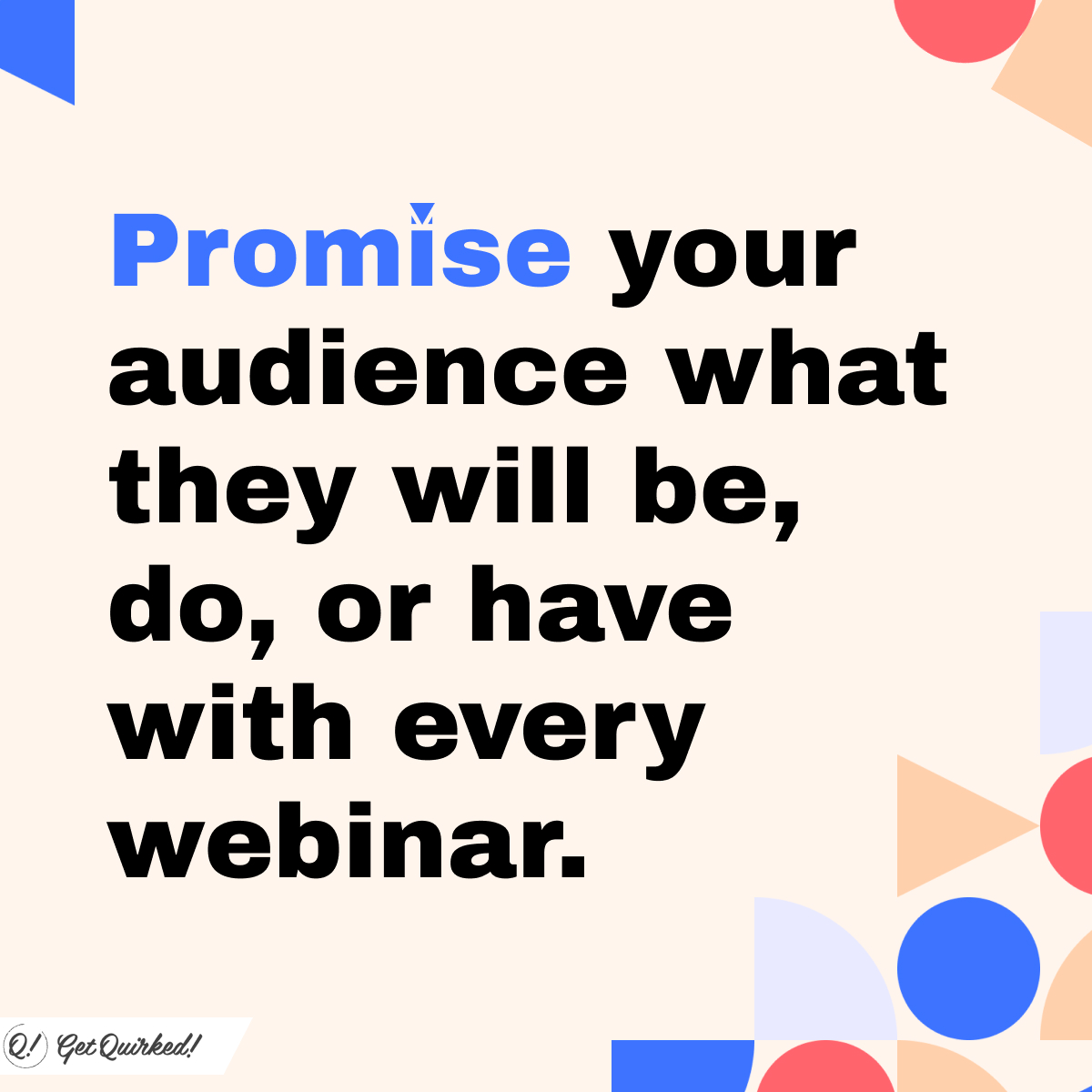
The promise you make to your audience is important
Always make sure you are committing a promise to your viewers. What will they be, be able to do, and or have after watching your webinar?
That’s where your promise should come from.
If you’re presenting a webinar on the journey companies should take when shifting from on-premise infrastructure into the Cloud, your promise might be, “Feel confident and secure in your move to the Cloud” or “Migrate to the Cloud quickly, confidently, and securely”.
This is a promise and one that your presentation should fulfill on.
Presenting Your B2B Webinars
When you present your webinar, you should:
- Establish the pain or frustration the audience is feeling about the topic
- Talk about your journey to identifying possible solutions
- Building & implementing the solution
- and what it’s like for you or your clients to not have that pain or frustration anymore + what you/they have, are able to do, or have become since implementing the solution.
Be sure to leave them with what their next best action is. You could have a few options here, but I would limit it to no more than 3.
One next best action could be to view more content. Another could be to ask for a meeting or a demo.
If this webinar is more of a sales close device, then you had better be asking for the sale and giving the audience very clear instructions as to how they pay you money.
You may also find that teasing a follow-up expectation will help your audience not forget who you are or what you just provided them. However, shit happens and we all forget stuff we learned.
Following Up with Attendees After your B2B Webinars
This is so critical to continue building rapport with your audience members. Even on-demand webinars need a follow-up game plan. While there are many ways to go about connecting with your audience post-webinar, I want to focus more on the message than the delivery channels here.
If you can, follow-up within the first 48 hours after a live webinar. If a recorded webinar, as soon as you get the lead information your comms should be ready to go out. Having a speedy start to your follow-up will help the audience members remember your webinar.
This doesn’t mean absolutely blast your audience super fast.
You are still going to provide value, and you’re going to continue to follow-up more than once.
Consistency and repetition will help your follow-up efforts.
How to follow up with B2B webinar attendees
When you follow-up, you want to remind your audience members of the value they received and any action steps they should be taking after the webinar.
Provide your key takeaways in the same context & form you presented them in. If you had them on a slide during the presentation, drop the slide into your communication. Pull stats out of your webinar content to share. If there were downloadable items like checklists or action plans, provide them again and explain their value one more time.
Make it easy for them to remember the value you presented, and even if they don’t I bet they are now intrigued to be reminded.
Don’t forget to give your audience actionable & valuable takeaways
For your takeaways, remember the “Be | Do | Have” model. This refers to what your audience will be, ability to do, or have after attending and learning from your webinar.
Here’s an example of each one to help see the model in practice.
- You will be confident in your decision to modernize your CRM
- You will be able to sell this modernization of the CRM to your sales & executive leadership easily
- You will have the blueprint and step-by-step guide to consulting with the most critical teams in your organization to kick off your CRM modernization efforts and ensure a successful migration, adoption, and continued improvement program.
These are designed to hit the emotional aspects in your audience, which you will have identified in the planning stage. If you don’t have these, please… pause what you’re doing, and go figure that shit out.
REMINDER: Even though it’s called “business to business (B2B)” marketing, we are still people interacting with people. An emotional component to your marketing should not be thrown out simply because of the name of our industry.
Using Recorded B2B Webinars to Build Content for Promotion
Atomize. Repurpose. Whatever you choose to call it, you’re going to take the gold nuggets found in your webinar and create bite-sized chunks of value from it. Then you will utilize these bite-sized chunks to continue to promote our webinar content to do at least one of two things.
The first, build and nurture your audience with valuable and actionable content. This is a secondary benefit of building your webinar with the process from before.
The second, re-run your webinar motion again and see how many more people will watch it even though they said no the first time, or missed it completely.
e.g. – You promoted your webinar to an audience of 1,000 and 125 registered, 75 showed up. You can now offer the webinar to the audience again as a simu-live or on demand format to see how many more of the 925 (original audience minus 75, since 50 registered folks didn’t show you can lump them back into the pool) show up.
Even if you only get another 75 to show up for the second run, that’s still 75 more people that converted. And if you can do that a third time with same or similar results, you now have a repeatable system that you should run until the numbers get lower than what it’s worth to run the promotion.
You do not need to re-build the wheel every time you need to generate leads, demand, and opportunities. Re-run the successful promotions again and again until they are no longer profitable.
Depending on the channel you intend to promote these bite-sized chunks from you may create multiple types of assets from each one. Below, I provide a few examples from my own Inbox, social feed, and recently came across via content syndication.
Sent from: Coveo
Subject line: How CIOs do GenAI right
Promoting B2B webinars with email
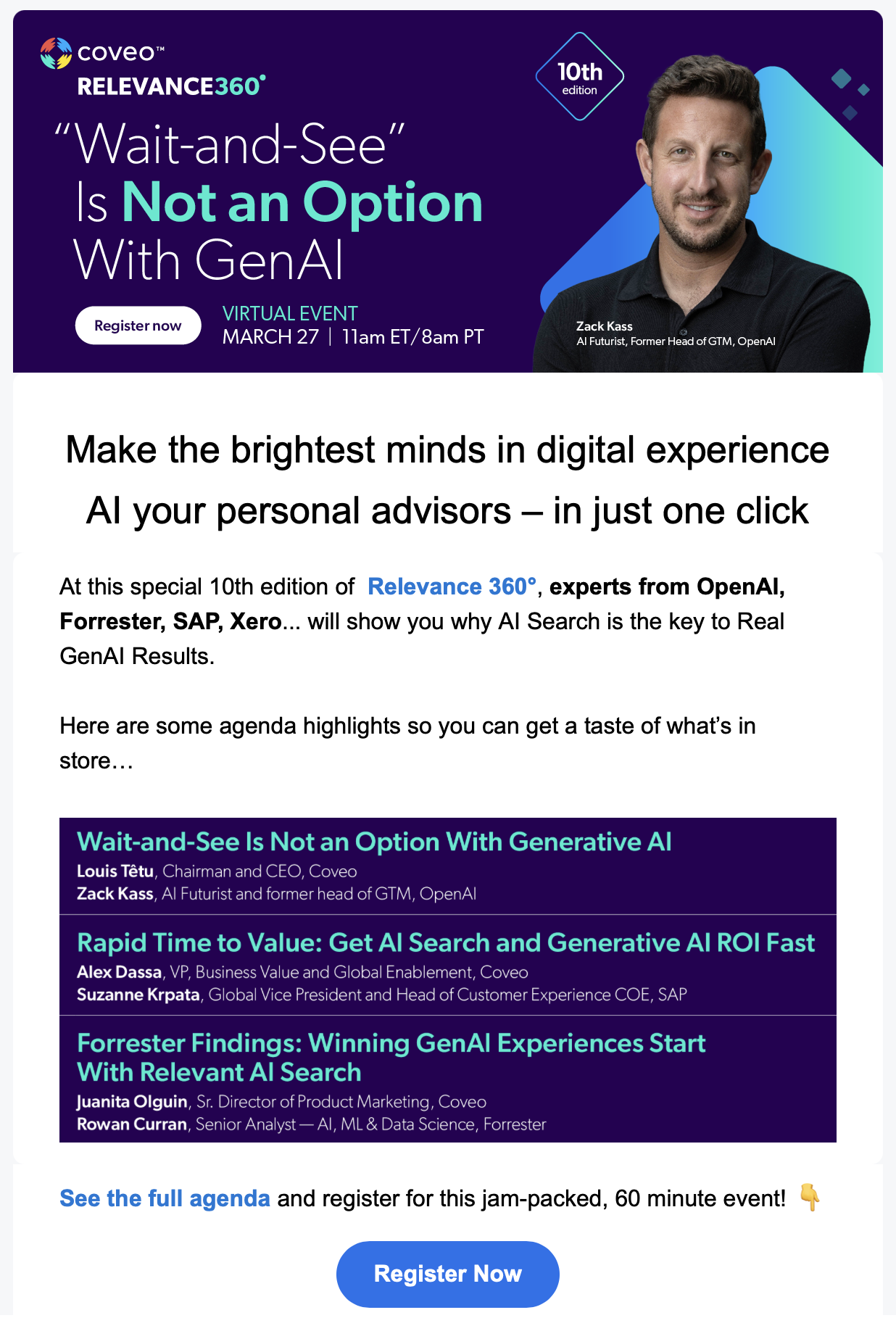
In this example from Coveo, the subject line really does nothing to entice me to learn more. The only reason I opened this was because I deleted the email just before it and it auto-opened.
Once open, I scanned the headline and was no closer to understanding why I should care about this. “’Wait-and-See’ is not an option with GenAI” at this point for me is table-stakes. This message may just not resonate with me as I have been a semi-early adopter with generative AI.
For the sake of this article, I read on.
The sub-head, “Make the brightest minds in digital experience AI your personal advisors – in just one click” has me confused, but I trudge on.
The agenda highlights have no context, just titles. Why? If I’m supposed to “get a taste of what’s in store…” why don’t you actually give me that? A short description for each session listed could go a long way if you can’t re-title the sessions. Even 2-3 bullets for what the audience member will be/do/have after attending could really help sell the value here.
All I know from this email is that there are 60 minutes filled with 3 presentations. I have no clue how this is allowing me to make these presenters my personal advisors. Will there be live Q&A? Will there be a comments thread to interact with the presenters?
HOW? Flipping tell me already!
Here are some ideas that Coveo could do differently:
- If this is the 10th edition, segment your audience for those that attended previously vs. everyone else. Even those that came might not see the value in coming again, so you really have to sell it with a promise and some of the takeaways they’ll receive (be/do/have). By segmenting, you can focus on making reference-able promises as well as new ones to those who have attended before while not being as casual with those who have never attended.
- Add session descriptions that can be indicative of the promise you make with your headline and introduction.
- If AI search is the key to real genAI results, you should dig into that and give at least one example. In my opinion 2-3 are best, but that can be overkill sometimes.
- Instead of “agenda highlights” show me some of the value I’ll receive from each of the sessions with a description or mini-sales letter or bullets.
Promoting B2B webinars with social media
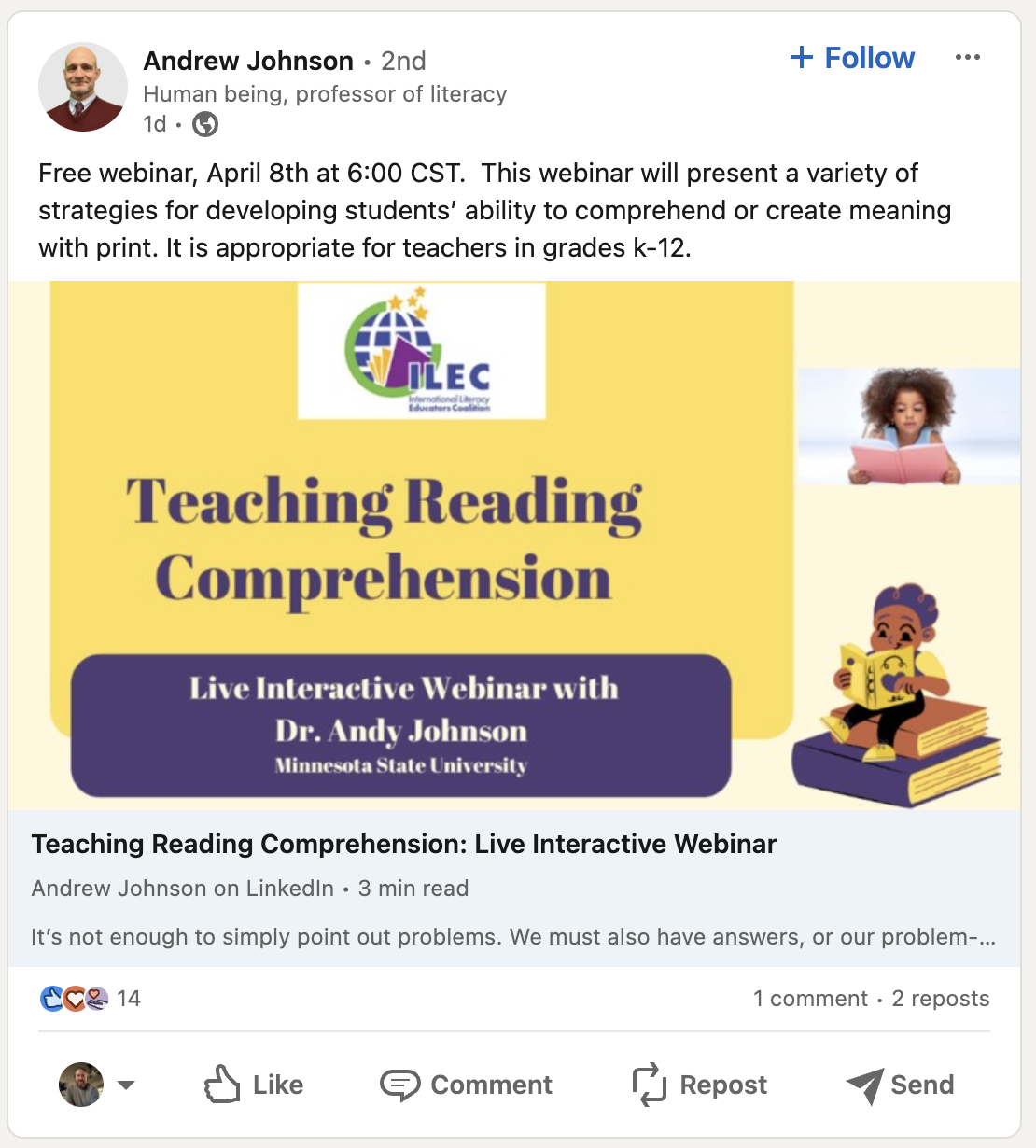
I freaking love this one. It get’s right to the point and follows many of my guidelines.
Out of the gate, “Free webinar”. Fantastic (maybe), I don’t have to worry about $$ for this. If this is for teachers (and hint, hint… it is) then this is a great point to lead with.
When and what time, very clearly state in the post copy (should it have been in the graphic? you tell me).
“This webinar will present” – I would change this to “give you” or “provide you”
“a variety of strategies for developing students’ ability to comprehend or create meaning with print.” – 2 critiques, but I think this is fine as it is…
- give a specific number of strategies
- expand just a bit on the strategies… pick 1-2 to give here in name or in what they help the teacher achieve, be specific
- BONUS: ties these two together for extra umph
Lastly, “appropriate for teachers” and “in grades k-12.” I mean, you specifically called out who this will benefit. Bravo, Andrew Johnson!
Promoting B2B webinars with Content Syndication
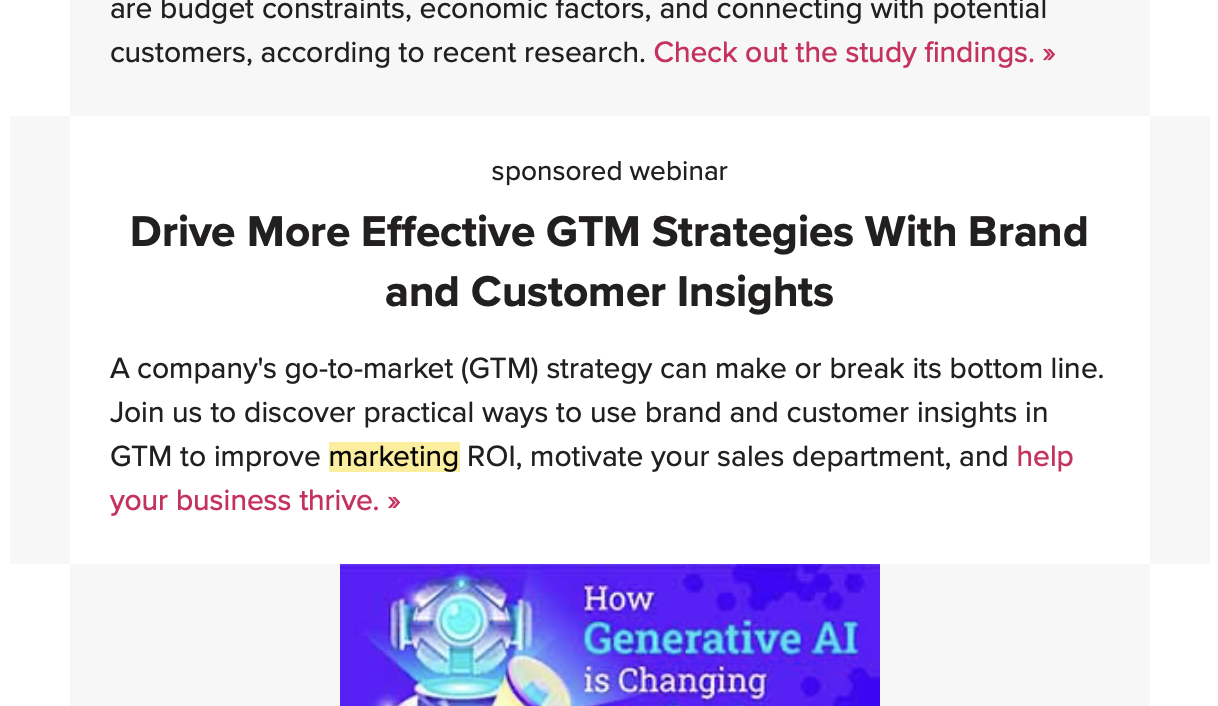
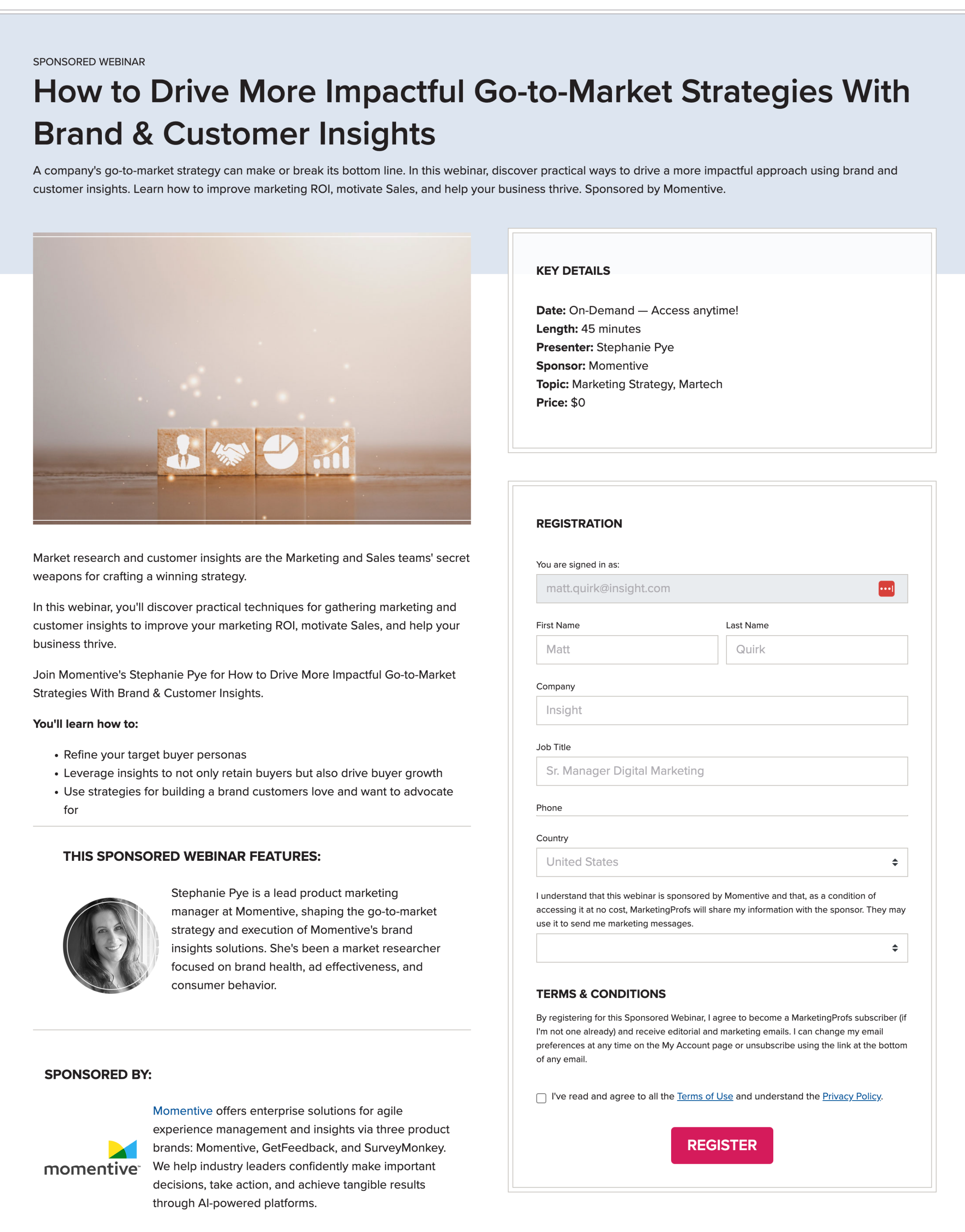
This is a screenshot taken from the MarketingProfs email newsletter with a Sponsored Webinar, which is done as a content syndication play.
The email links back to MarketingProfs.com, but it’s a unique opt-in page for this webinar which is someone else’s content that MarketingProfs is promoting via their networks newsletter.
Right off the bat, the headline pulls me in because it makes a promise. “Drive more effective GTM strategies with Brand and Customer Insights”, well done.
While this ad placement is limited in characters, I would have opted for maybe 1 sentence description and 2 bullets.
The sentence could have been, “Watch now and you’ll be using brand & customer insights next week to:”
And the bullets:
- Improve marketing ROI (tied to engagement, pipeline, and closed won)
- Motivate your sales teams with clear focus and tools they can use
This is actually less characters and words, and does a better job of selling the promise more clearly. In my opinion, of course.
Conclusion
I’m not going to try to re-cover everything in this article as that would be a lot to detail, so here are my top takeaways.
- Build your webinars with your best customers in mind. Topically specific to what they care about and using the webinar to help them take at least one step forward to solve the problem they are dealing with.
- Plan to take them on a journey, in each webinar. Most people only “tell & sell” with their webinar content that I’ve seen in the past 6+ years of my technology marketing career. We want to use story and my mantra, Demonstrate you can help people by actually helping them, to “sell” the audience. Make them a promise and fulfill on that promise.
- When you promote, do so with actual value in mind and with the promise you’re making your audience in mind. Give away some of the good stuff you’re providing to the audience while you promote the webinar.
- Don’t do anything only once. If you film a 30 min webinar and have followed the advice in this article for the structure and content, you have at least 4-5 gold nuggets you can pull out of the whole webinar to share in bite-sized form and provide the same value to more people on social or via email.

